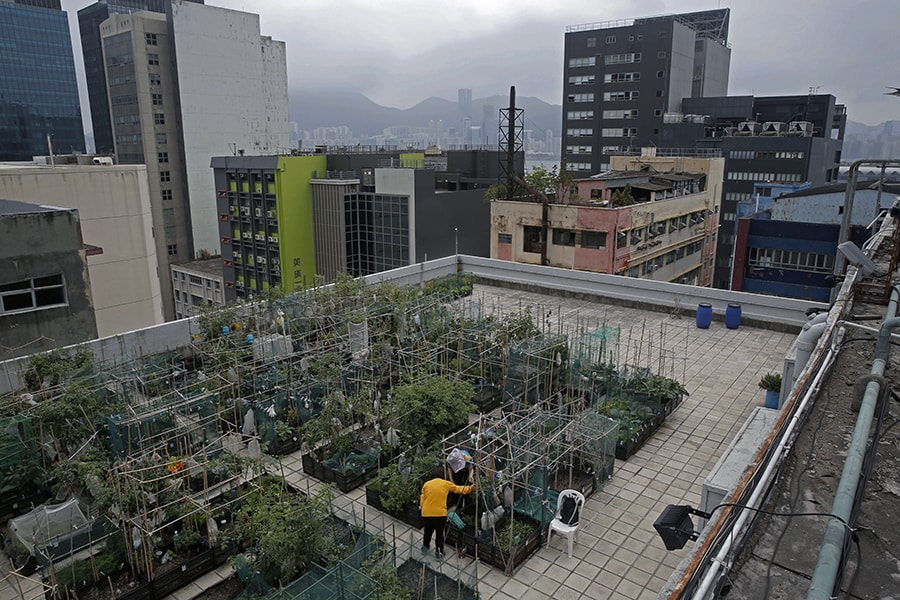Why you should spend more time outdoors — at the office
By Brian Krenke

In this March 18, 2018, photo, farmers work at a rooftop vegetable garden of an industrial building in Hong Kong. High above downtown Hong Kong's bustling, traffic-clogged streets, a group of office workers toil away. They're working not on a corporate acquisition or a public share offering but on harvesting a bumper crop of lettuce atop one of the skyscrapers studding the city's skyline. (Kin Cheung / AP)
Americans don’t get out much anymore. We’re indoors for 90 percent of each day, according to the Environmental Protection Agency.

Brian Krenke
For a big chunk of that time, many of us are behind a desk or otherwise at work. One study found that just one-quarter of office workers spent more than an hour outside each day.
Research shows that people who are cooped up all day have less energy and worse moods. That’s bad news not just for them but for their employers. After all, a happy, energetic worker is more productive.
Consequently, employers really ought to encourage their staffers to spend more time outdoors during the workday. Oddly enough, urging employees to log fewer minutes at their workstations can yield better outcomes for bosses.
Our indoor existence is hazardous to our health. Electrical lighting disrupts our natural circadian rhythms, which makes it harder to sleep. Limited exposure to sunlight can lead to depression.
Just a bit of time outdoors can counteract these negative health outcomes. One 2010 study found that even a five-minute walk outside can boost mood and self-esteem.
Greenery can be a particularly effective medicine. According to one study, a 90-minute stroll through nature decreased negative thinking more than a walk for the same amount of time in a city. Research out last year found that exposure to greenery reduces the risk of cardiovascular disease, type 2 diabetes, and other illnesses. Listening to the sounds of nature can actually lower our blood pressure.
A University of Pennsylvania study published in 2018 by JAMA, a medical journal, found that giving communities access to green spaces like small gardens or parks reduced feelings of depression by over 40 percent.
Harnessing the mood-altering power of nature at the office is one way for employers to ensure their workers are in the right state of mind and performing their best.
Of course, managers can’t let their teammates spend the bulk of the workday wandering around outside. But with the right design, employers can empower people to work productively outdoors.
That design need not be fancy — outdoor patios, small gardens, picnic tables with umbrellas, and laptops that can be checked out. The biggest hurdle for many companies may be cultural — embracing the idea that work can get done outside.
Tech companies have been among the earliest adopters of this approach. KI Furniture recently conducted interviews with almost 400 architecture and design experts at the fastest-growing tech companies. They found that 40 percent of these firms already have outdoor workspaces.
There are also plenty of ways to bring nature into the office. The technical term for this approach is “biophilic design,” and it can deliver significant benefits. Employees in offices that incorporate natural elements are 15 percent more productive than those in offices without them.
Employers aren’t just depositing potted plants all over the office — though that can help. McDonald’s has built a plant-covered wall in its new Chicago home base. According to the fast-food titan’s CEO, the newly designed building “fosters collaboration and re-energizes employees.”
Amazon has famously taken biophilic design to the next level. The three Spheres — 90 feet tall, dome-shaped offices that double as greenhouseslet up to 800 people at its Seattle headquarters work in a veritable forest full of plants and trees. The Spheres house everything from cafés to private meeting nooks.
Not every company can build a jungle inside its offices. But when something as simple as scattering plants throughout a building can increase well-being by 40 percent, it’s worth it for employers to explore how they can make the great outdoors a bigger part of their workday.
Brian Krenke is CEO of KI Furniture.
